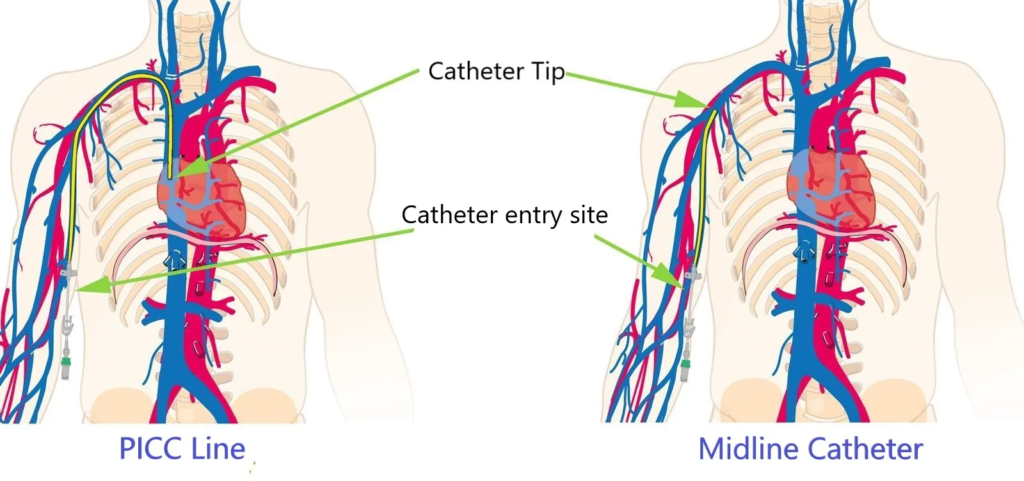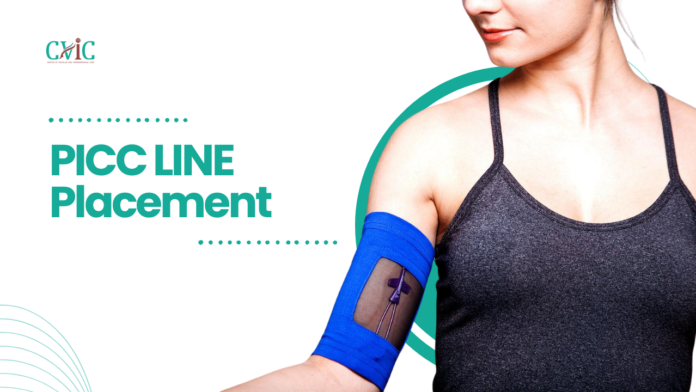A PICC line, or Peripherally Inserted Central Catheter, is a form of intravenous access that can be used for a prolonged period of time, typically weeks to months, to administer medications, nutrients, or fluids, and for blood draws. The PICC line is a flexible, long, thin tube inserted into a peripheral vein, usually in the arm, and then advanced until its tip rests near the heart, allowing direct access to the central circulatory system. This detailed blog aims to explore the procedure for PICC line placement, its benefits, potential complications, and care instructions.
What is a PICC Line?
A PICC line is a type of central venous catheter that is less invasive than other forms of central venous access, like those inserted into the neck or chest veins. The flexibility and comfort of having a PICC line make it a preferred choice for long-term intravenous therapy.

Indications for PICC Line Placement
PICC lines are commonly used for:
- Long-term antibiotic therapy
- Chemotherapy
- Total parenteral nutrition (TPN)
- Frequent blood draws for laboratory tests
- Administration of medications that are irritating to smaller veins
The Procedure
The placement of a PICC line is a sterile procedure that is usually performed in a hospital or outpatient setting. The process typically involves the following steps:
Preparation: The patient is positioned comfortably, and the insertion site is cleaned and disinfected. The patient is covered with sterile drapes to maintain a sterile field.
Vein Selection and Access: A vein in the upper arm is located using ultrasound guidance. This imaging helps in avoiding nerves and arteries that are close to the selected vein.
Catheter Insertion: Once the vein is accessed, the PICC line is threaded through the needle, and the needle is removed. The catheter is then advanced until its tip is positioned in a large vein near the heart, which is confirmed with an X-ray.
Securing the Catheter: The PICC line is then secured to the skin with a sterile dressing to prevent it from moving or being pulled out.
Final Steps: The insertion site and the PICC line are covered with a clear dressing that allows for easy monitoring of the site for any signs of infection.

Benefits of a PICC Line
- Long-term Access: It can remain in place for weeks to months, reducing the need for repeated needle sticks.
- Comfort: It is more comfortable over time compared to other types of IV access.
- Reduced Risk of Infection: When cared for properly, PICC lines have a lower infection risk than other central lines.
Potential Complications
Although PICC lines are generally safe, they can be associated with certain risks, such as:
- Infection at the insertion site or in the bloodstream
- Blood clots (Deep vein thrombosis)
- Catheter occlusion (blockage)
- Accidental removal or dislodgement
PICC Line Care
Proper care is crucial to prevent complications. This includes:
- Regular dressing changes
- Flushing the PICC line as recommended to prevent blockage
- Monitoring for signs of infection, such as redness, swelling, or discharge at the insertion site
- Avoiding pulling or tugging on the PICC line

Conclusion
PICC line placement is a valuable procedure for patients requiring long-term intravenous therapy. It offers several benefits, including comfort and reduced need for multiple needle sticks. However, like any medical procedure, it carries risks that can be mitigated with proper care and monitoring. Understanding these aspects of PICC line placement and care can significantly impact patient outcomes positively.
Our Doctors
Dedicated IR Center for Vascular Problems in Madhya Pradesh
DR. SHAILESH GUPTA
MD, PDCC (INTERVENTIONAL RADIOLOGY) Consultant & Co-Director CVIC (Center Of Vascular & Interventional Care)
DR. ALOK KUMAR UDIYA
MD Radiology, PDCC (Neurointervention Radiology), PDCC ( HPB Intervention Radiology) FINR (Switzerland) & EBIR
Endovascular Surgeon & Consultant Interventional Neuroradiologist at Care CHL Hospital, Indore Co-director CVIC( center for vascular and interventional care)https://interventionradiologyindore.com/
DR. NISHANT BHARGAVA
Consultant Intervention Radiologist
MD Radiology, PDCC ( Neurointervention Radiology), FINR ( Fellowship in Neurointervention Radiology)
Co-director CVIC(Center for Vascular and Interventional Care)
Contact Details
Phone no.
0731 4675670
+91 9827760073
Facebook
https://www.facebook.com/profile.php?id=100092538633553&mibextid=ZbWKwL
Instagram
https://instagram.com/cvic_center?igshid=ZGUzMzM3NWJiOQ==
Google My business
https://g.co/kgs/DrdV3T
YouTube
https://www.youtube.com/channel/UCP5TH5e4iQZkpDUgnLsgZhw
Pinterest
https://pin.it/5DzpX5Z
Twitter
https://x.com/cviccenter?t=01TclSrLFdu0K2re0Gs96w&s=08
LINKEDIN
https://www.linkedin.com/company/center-of-vascular-interventional-care/
Location
Read More –
Flow Diverter Placement for Brain Aneurysm – https://cvicvascular.com/flow-diverter-placement-for-brain-aneurysm/
Dural AVF Embolization in Neuro Intervention – https://cvicvascular.com/dural-avf-embolization-in-neuro-intervention/
Tumor Biopsies in Oncology Intervention – https://cvicvascular.com/tumor-biopsies-in-oncology-intervention/




